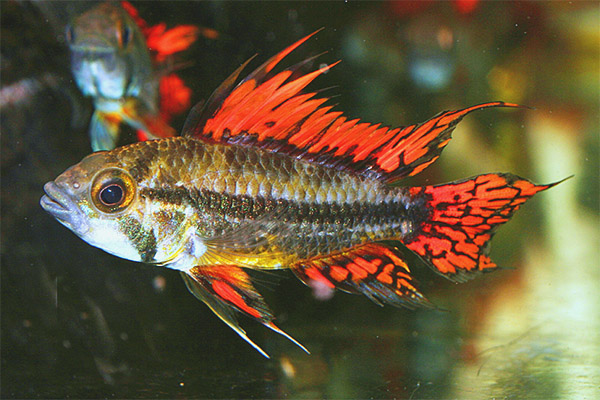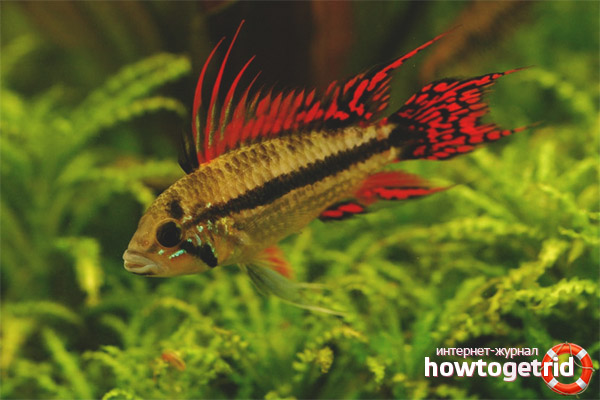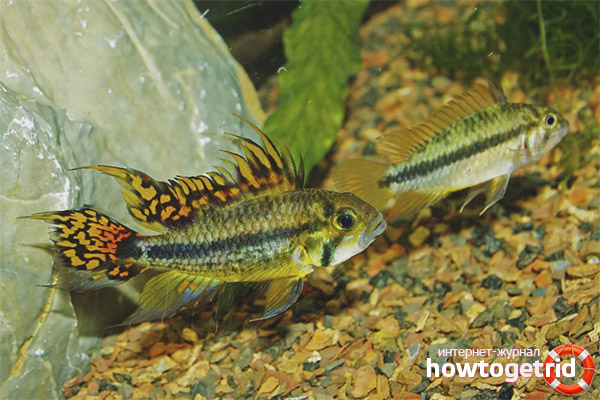The content of the article
For the aquarium fish called cockatoo apistogram you can watch for hours, its life is so interesting. And the combination of the color palette is very interesting for her, and the thought involuntarily arises - is she the prototype of the Golden Fish from the Pushkin fairy tale? True, its habitat is not the bottom of the sea, but quiet, shallow rivers or bays, streams and backwaters that are found in the tropics of Colombia, Brazil and other countries of South America. These fish most often prefer places with weak current or stagnant water, are near stones, where you can always hide, as well as near areas where the bottom is soft and there are a lot of plants.
It received its name due to the similarity with the cockatoo parrot - due to the structure of the dorsal fin. And she is loved among fans of aquarium fish as the most beautiful among cichlids.
Bright and radiant
This fish was described in detail for the first time in 1951. The cockatoo apistograms are small but noticeable and have a body that is typical of dwarf cichlids. Some differences:
- Males are much larger, have a length of up to 10 cm, but in captivity they are born a little less - up to 8 cm, brighter. The first rays of the dorsal fin are located upwards, on the fins of the caudal and dorsal rays are more elongated and sharp. Caudal fin noticeably concave, but abdominal elongated.
- Females - up to 5 cm. Much paler, yellowish color dominates in them. But during the period of caviar care, their color becomes a bright lemon shade and longitudinal dark stripes are marked.
These fish have a longitudinal dark stripe.It begins at the snout and stretches to the caudal fin. Its end is a dark spot with a white edging. But sometimes this band is a separate spots. There are dark spots on the back that capture part of the dorsal fin. Almost all males on the caudal fin can see magenta spots.
An apistogram of a cockatoo near looks rather frightening because of the protruding massive mandible.
Fish live under good conditions for about 5 years.
Eating a cockatoo apistogram
These fish are not picky. They, like true predators, are used to eating all those who are nearby. First of all insects that live on the bottom, their larvae, plankton fall into this category. Aquarium species are also omnivorous, therefore they eat live, frozen and even artificial food. Still, they prefer the larvae of mosquitoes, ducts, and daphnias.
Life behind glass
Even a beginner can take care of the cockatoo fish, as these aquarian inhabitants quickly adapt and behave quite peacefully.
For a pair of purchased aquarium, the volume of which ranges from 70 liters.But usually the cockatoo apistogram prefer a harem lifestyle, therefore, it is better to keep one male and several females. But for such a large family the displacement will require more - up to 100 liters.
The composition of the water should be with a high content of dissolved oxygen, and the flow should be moderate. To create such a microclimate, use a filter, preferably an external one. It must be remembered that this fish is sensitive to the level of ammonia and to nitrates. Ground siphon and periodic water change are required.
The soil is needed soft, better sand, so that the fish would be comfortable in it, they are almost always at the bottom. One should take care of a large number of plants, put dry leaves on the bottom, prepare all kinds of shelters for them, using stones, driftwood, dense thickets, caves. Each female should have them, but in different places so that a definite has its own safe territory.
Temperature comfort mode is from 23 to 27 degrees of heat. There should be a soft light in the aquarium.
Compatibility with other species
The apistogram of the cockatoo is mostly non-aggressive, therefore it coexists normally with other species similar to them in size. This, above all, tetras, barbs, haratsinovye.Only in isolated cases does a large male attack fish, which are much smaller. If small shrimps and fry are added to the aquarium, it is likely that they will be eaten. During the spawning period you can expect from this type of aggressive behavior.
However, at other times it is real phlegmatic. And due to the fact that they are not as agile and active as others, it is likely that they will be pushed aside from the feed.
Procreation
For these fish, it is not a problem to spawn in an aquarium not only separately, but also in general. About 80 - 100 eggs can lay a female cockatoo, attaching them to the walls of shelters.
The owners of the aquarium should make sure that the temperature before the spawning was 23 degrees, but then for two days it increased, but not more than 5 degrees. Aeration and replacement of water are required, and by 1/5, preferably on peat. In spawning, the temperature must be not lower than 29 degrees, and the pH level should not fall below 7.5, only then the eggs will be able to turn. Water should be sour and soft, then spawning will be with a positive result.
A good pair is necessary for the future offspring, but it is better to buy more than 5 fry and grow them. In most cases, much is rejected, and often a single pair remains.
During the period of courtship, the behavior of the male is very original: he dances in front of the chosen one, bends, performs intricate movements, simultaneously demonstrating his bright color. Having achieved attention, the male attracts the attention of the female, and they go to the shelter. After the eggs are attached to the surface, the task of the male is to fertilize them, and then protect the clutch. If there are several, the male has time to visit each shelter, mating alternately with several individuals. But does not refuse anyone, protecting the future offspring. The incubation period is usually from 2 to 3 days.
When several females appear at the same time fry, their theft begins. Moms try to take them away from each other and move them to their shelter.
In order for the fry to develop and grow without problems, stable parameters should remain in the aquarium for the first 21 days. The offspring grows quickly, the starting food for it is the smallest microorganisms, live dust, rotifers and even egg yolk.
Females can breed after 8 - 10 months.
Professionals advise that during the breeding of the apistogram, it is imperative to carry out selection work, sorting out the fry, leaving the brightest colors.If this is not done, then several generations will be enough for the fish to lose their festive appearance, and the representatives themselves will experience complete degeneration.
Video: aquarium fish apistogramma cockatoo













To send